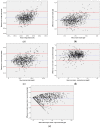Relative Validity of a 24-h Recall in Assessing Intake of Key Nutrients in a Cohort of Australian Toddlers
- PMID: 29329266
- PMCID: PMC5793308
- DOI: 10.3390/nu10010080
Relative Validity of a 24-h Recall in Assessing Intake of Key Nutrients in a Cohort of Australian Toddlers
Abstract
There is limited information concerning the dietary intake of toddlers in Australia. Consequently, there is a need for studies investigating toddler intake that use dietary assessment measures that are valid and place a low participant burden on caregivers. The aim of this study was to determine the relative validity of a single 24-h dietary recall (24HR) in measuring the intake of five nutrients in a cohort of Australian toddlers compared to a combined 24HR and 2-day estimated food record (2DFR). A single 24HR and a 2DFR were collected from a cohort of Australian toddlers (n = 699) at approximately 12 months of age as part of the Study of Mothers' and Infants' Life Events affecting oral health (SMILE) project. Relative validity of one day of dietary data (24HR) in assessing intake of energy, protein, calcium, iron, and added sugars was tested against three days of dietary data (24HR + 2DFR) using paired t-tests, Bland-Altman analysis, cross-classification, and weighted Kappa statistic. Classification analysis found good agreement between the 24HR and 24HR + 2DFR for all nutrients with the percentage classified in the same tertile at 57.9% and above. The weighted Kappa statistic found acceptable agreement for all nutrients. This study suggests that a 24HR is a valid assessment tool for estimating the relative intake of energy, protein, calcium, iron, and added sugars among Australian toddlers at the individual level.
Keywords: 24-h dietary recall; food record; nutrient intake; relative validity; toddlers.
Conflict of interest statement
The authors declare no conflict of interest.
Figures

References
-
- Australian Institute of Health and Welfare . 2010 Australian National Infant Feeding Survey: Indicator Results. Australian Institute of Health and Welfare (AIHW); Canberra, Australia: 2011.
-
- Australian Bureau of Statistics . Australian Health Survey: Nutrition First Results—Food and Nutrients, 2011–2012. Australian Bureau of Statistics (ABS); Canberra, Australia: 2014.
Publication types
MeSH terms
Substances
LinkOut - more resources
Full Text Sources
Other Literature Sources

